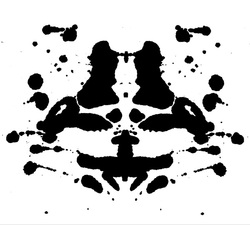 Having a background in psychology I possess great respect for the tools and methods clinicians have developed to infer people’s underlying motives, attitudes and intentions. As a consumer researcher I use some of these tools to obtain valuable insights about brands, products and services. One popular group of tools spanning the clinical and consumer research worlds are known as projective techniques. The most well-known projective test in the clinical world would have to be the Rorschach Inkblot Test (pictured) where a series of ambiguous images are shown and subjects are asked to describe what they see. One might question how techniques like this have any bearing on brands and businesses but the answer lies in their ability to reveal what someone is thinking and feeling indirectly as opposed to responses obtained from more direct lines of questioning.
Direct lines of questioning are coming under fire for only capturing superficial or rational responses devoid of emotional intelligence. All evidence to date suggests our emotions hold sway over our reasoning (even if our reasoning finds this difficult to believe). Therefore as researchers we must get beyond the rational so we can better understand the ‘real heart’ inside consumers. Projective techniques offer one way of doing this. 5 types of projective techniques One helpful way to categorise projective techniques is based around the nature of the activity involved and how far consumers are being asked to project their thoughts and feelings. Five categories are commonly identified. 1. Association – the simplest type of projective technique involving consumers being presented with a stimulus and responding with a word, image or thought. Word association and brand personification exercises fall into this group. 2. Completion – here consumers are presented with an incomplete sentence, story or conversation and are asked to generate additional details to create a finished product. Sentence completion exercises and bubble drawings fall into this group. 3. Construction – consumers are asked to write descriptions or a story about a stimulus. If the stimulus is a picture then consumers may be required to create a story in the lead up or after what is being depicted. Or they could be asked to describe what the people in the picture are thinking and feeling. Construction techniques are less structured than completion techniques thus more projection is required from consumers. 4. Expressive – here consumers are asked to relate others feelings or attitudes about a stimulus by assuming the role or behaviour of an object or another person. This group of techniques is probably the hardest for consumers to engage with and asks the most of them in terms of projection. Role play exercises fall into this group. 5. Choice – after undertaking a task involving a range of stimulus consumers are asked to explain why certain things are grouped together or why they are ordered in particular ways. Mapping tasks or ranking exercises fall into this group. Advantages & disadvantages of projective techniques On the one hand, there is criticism over projective techniques because the results often mean very little on their own, requiring interpretation to make sense of them. The fact that these techniques are employed to uncover what may normally have remained hidden means it is difficult to validate these interpretations. Researcher interpretations may also be highly subjective and differ between researchers, meaning that projective techniques also lack scientific reliability. Consumers can also find it difficult to project themselves into the roles being asked of them or may feel too embarrassed to fully participate in the activities which can limit their usefulness. On the other hand, these techniques afford rich insight into consumer’s thoughts and feelings enabling brands to develop products and services or communicate with consumers in ways that deeply resonate. The techniques are unstructured and novel therefore there aren’t any obvious right or wrong answers which circumvents consumers from behaving in socially desirable ways and responding with less honesty. Projective techniques may be criticised for their subjective and unscientific nature but it is precisely these characteristics that make them so perfect for researching consumer emotions. When projective techniques are well designed and interpreted they deliver untold value to brands and businesses through the qualitative data collection process.
2 Comments
28/8/2019 11:54:11 pm
I have read a lot of articles about this in the past, however, I never expected to read something like this. Well, aside from the new insights that you have, there are also ones that I truly excited me. I know for a fact that you did your research, in fact, I am happy that you did. I learned so much from this blog that you wrote, and I am happy that you wrote it. I hope to read more of your insights.
Reply
Your comment will be posted after it is approved.
Leave a Reply. |
AuthorDonna Bonde is the Owner and Director of Rapture Consulting. She consults to agencies and brands who want to better understand the way consumers think and behave. She bases herself in Sydney, Australia. Archives
May 2024
Categories
All
|
Proudly powered by Weebly

